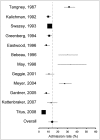How many scientists fabricate and falsify research? A systematic review and meta-analysis of survey data
- PMID: 19478950
- PMCID: PMC2685008
- DOI: 10.1371/journal.pone.0005738
How many scientists fabricate and falsify research? A systematic review and meta-analysis of survey data
Abstract
The frequency with which scientists fabricate and falsify data, or commit other forms of scientific misconduct is a matter of controversy. Many surveys have asked scientists directly whether they have committed or know of a colleague who committed research misconduct, but their results appeared difficult to compare and synthesize. This is the first meta-analysis of these surveys. To standardize outcomes, the number of respondents who recalled at least one incident of misconduct was calculated for each question, and the analysis was limited to behaviours that distort scientific knowledge: fabrication, falsification, "cooking" of data, etc... Survey questions on plagiarism and other forms of professional misconduct were excluded. The final sample consisted of 21 surveys that were included in the systematic review, and 18 in the meta-analysis. A pooled weighted average of 1.97% (N = 7, 95%CI: 0.86-4.45) of scientists admitted to have fabricated, falsified or modified data or results at least once--a serious form of misconduct by any standard--and up to 33.7% admitted other questionable research practices. In surveys asking about the behaviour of colleagues, admission rates were 14.12% (N = 12, 95% CI: 9.91-19.72) for falsification, and up to 72% for other questionable research practices. Meta-regression showed that self reports surveys, surveys using the words "falsification" or "fabrication", and mailed surveys yielded lower percentages of misconduct. When these factors were controlled for, misconduct was reported more frequently by medical/pharmacological researchers than others. Considering that these surveys ask sensitive questions and have other limitations, it appears likely that this is a conservative estimate of the true prevalence of scientific misconduct.
Conflict of interest statement
Figures






References
-
- Saunders R, Savulescu J. Research ethics and lessons from Hwanggate: what can we learn from the Korean cloning fraud? Journal of Medical Ethics. 2008;34:214–221. - PubMed
-
- Service RF. Scientific misconduct - More of Bell Labs physicist's papers retracted. Science. 2003;299:31–31. - PubMed
-
- Marshall E. Scientific misconduct - How prevalent is fraud? That's a million-dollar question. Science. 2000;290:1662–1663. - PubMed
-
- Sovacool BK. Exploring scientific misconduct: isolated individuals, impure institutions, or an inevitable idiom of modern science? Journal of Bioethical Inquiry. 2008;5:271–282.
-
- Bogner A, Menz W. Science crime: the Korean cloning scandal and the role of ethics. Science & Public Policy. 2006;33:601–612.
Publication types
MeSH terms
LinkOut - more resources
Full Text Sources
Other Literature Sources

